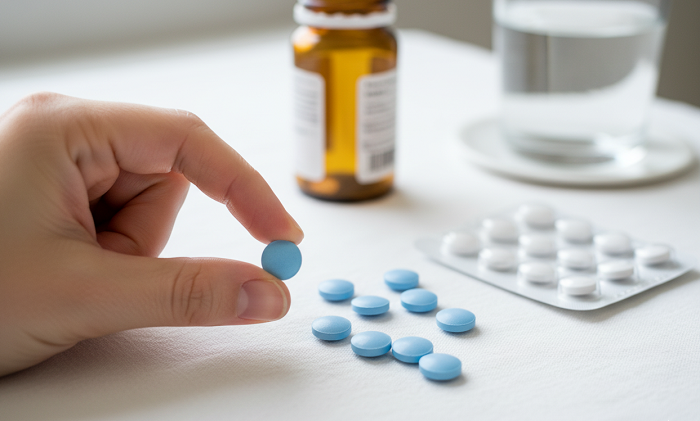In This Blog
- Klonopin is a benzodiazepine used to treat seizures and panic disorders.
- The drug may remain in your system for 6–9 days on average.
- Klonopin is likely to show up on urine tests anywhere from a week to 30 days after use.
- How long it lasts can depend on several factors, including age, liver health, dosage, and frequency of use.
- The dangers of withdrawal and addiction mean medical supervision is crucial when stopping.
What is Klonopin?
Klonopin is a psychoactive drug that is chemically known as clonazepam and falls under the benzodiazepine family. The query that has been clamorously sought, whether it is a benzodiazepine, is perhaps conclusively answered. Its pharmacodynamic action is due to its promotion of neuronal activity in the central nervous system, which enhances the inhibitory effect of the neurotransmitter gamma-aminobutyric acid (GABA). This neuromodulatory effect brings a tranquilizing effect to peripheral and central neuronal networks.
Klonopin is medically used in the treatment of epilepsy, panic disorder, and, in some specific cases, motor disorders due to neuromuscular etiology. It enhances the transmission of GABAergic projections from the neuron and, as a result, reduces neuronal hyperexcitability and has a proven result in the reduction of the severity of clinical symptoms.
Experts Advise: Never take Klonopin in any way other than as it is prescribed. Never go off your dose or stop taking your medication without checking with your clinician.
What is Klonopin Used For?
Klonopin (clonazepam) does not generally carry a high risk of recreational abuse, but it is given to those patients who show signs of anxiety or sleeping irregularities. It has the following therapeutic profile:
- Panic disorder: It alleviates the state of panic, fear, and terror.
- Seizure disorders: It is used in Lennox-Gastaut syndrome, akinetic seizures, and myoclonic seizures (see accompanying WARNINGS on contraindications).
- Motor disorders: It is also sometimes used to treat restless legs syndrome or tremor.
Klonopin is therefore considered the long-term anxiolytic of choice as opposed to the short-term agent Xanax, which is only used on a situational basis.
100% Confidential Support is Available 24/7
No matter what you’re going through, you’re not alone. Our dedicated team is here to provide a safe, judgment-free space where you can talk openly and honestly. Whether you need emotional support, resources, or just someone to listen.
We’re here for you—completely confidential and always respectful of your privacy. Call us today!
Klonopin Side Effects
Any pharmacologic agent is associated with a risk of adverse side effects; the effects of Klonopin may be mild or severe. The side effects most frequently occur as:
Common side effects:
- Drowsiness or fatigue
- Clumsy movement or vertigo.
- Loss of memory or lack of concentration
- Irritability or low mood
- Anorexia or slight nausea.
Serious side effects:
- Respiratory depression
- Severe confusion
- Loss of consciousness
- Ideation of self-harm
- Depressive moods
In case patients or caregivers get such severe reactions, emergency medical help should be obtained as soon as possible.
Fact: The number of lethal benzodiazepine overdoses in the United States exceeded 10,000 in 2023, most of them involving Klonopin, and several of them mixed with fentanyl.

Contact Palm Coast Treatment Solutions
Battling with Drug and Alcohol Addition? Remember, you are not alone and we are here to help you!
Klonopin Overdose
Accidental or deliberate overdosing of a dose that is more than the recommended therapeutic amount is the most common overdose cause and may be fatal. The clinical characteristics of overdose are usually characterized by:
- Very drowsy or unconscious.
- Weak reflexes and blurred vision.
- Deep slow breathing or shallow respiration.
- Progression to coma
The usage of Klonopin is now a research-only drug in some jurisdictions. The antagonist benzodiazepine flumazenil can be used in hospitals to reverse the effect of the drug, but it may cause the danger of seizures.
Overcome Addiction with Palm Coast Treatment Solutions.
Book an appointment.
Klonopin Medication: How Is It Used?
Avoid alcohol, opioids and other sedatives.
- Typically given in the form of an oral tablet.
- Doses differ by condition (seizures vs panic) based on this condition.
- Either daily or every other day because it has a long half-life.
- Do not use alcohol, opioids, or other sedatives.
Klonopin is a Schedule IV controlled substance and doctors are watched carefully in terms of prescribing it to prevent abuse and dependence.
How Long Will One Klonopin Stay in Your System?
The half-life of clonazepam is reported to be between 20 and 50 hours. The half-life refers to the time it takes the plasma concentration to reduce by 50. It normally requires six to nine days, or six to nine half-lives, to eliminate the drug in the body since the last intake.
The Klonopin concentration in a person’s system is regulated by:
- The age and overall health conditions
- Liver activity; dose taken (say 5 mg as compared to higher doses)
- Frequency and duration of use
Any other medications that may interfere with hepatic activity.
Start your recovery journey with Palm Coast Treatment Solutions
Overcome Addiction with Palm Coast Treatment Solutions.
Book an appointment.
Klonopin Detection in the Body: Test Windows
Test Type | Detection Time |
Blood | 2–3 days |
Urine | 4–30 days |
Saliva | 5–6 days |
Hair | Up to 28 days |

Visual Timeline of Detection
To make the detection times easier to understand, the following simplified timeline is provided:
- The biotransformation of the pharmacologic agent does not disappear, and the blood concentrations are high in the first 24 hours.
- 24-48 hours: The levels of the fatty acid components, along with the related proteins, are steadily decreasing, and the state of energetic activity decreases in general.
- 2-3 days: the substance is found in the plasma and saliva.
- 4-9 days: Infrequent users may have the drug revealed in their urine.
- Up to 30 days: The compound can still be found in the urine of serious users.
- Up until 28 days: There is a possibility that the metabolites are present in the hair samples.
This timeschedule only shows the distribution of detection windows of different tests.
Overcome Addiction with Palm Coast Treatment Solutions.
Book an appointment.
Klonopin Stay in Your Urine
- Non-frequent users: The detection time is 4-9 days.
- Chronic users: Can be detected for a maximum of 30 days.
- The main aim of laboratory examination is to identify the 7-amino-clonazepam metabolite.
As a result, with light users, multiple days would answer the question of whether Klonopin will be detected in urine tests; with long-term users, the clearance window will be one month.
100% Confidential Support is Available 24/7
No matter what you’re going through, you’re not alone. Our dedicated team is here to provide a safe, judgment-free space where you can talk openly and honestly. Whether you need emotional support, resources, or just someone to listen.
We’re here for you—completely confidential and always respectful of your privacy. Call us today!
How Long Will Klonopin Show Up on a Drug Test?
Klonopin can be detected using several tests:
- Blood test: 2 to 3 days after taking.
- Urine test: It can be detected between 2 and 4 days after ingestion and also between 1 and 2 weeks, depending on the duration and frequency of use.
- Saliva test: Can be detected up to 5-6 days.
- Hair test: Up to 28 days or more.
In other words, so far as you are considering whether Klonopin will turn up on a drug test, yes, in a dozen different ways.
Factors That Influence How Long Klonopin Stays
Numerous factors make Klonopin persistence on the whole; the following factors have an effect:
- Age: Elderly people take longer to metabolize the drug.
- Hepatic impairment: The reduction in clearance in patients with impaired liver functioning is noted.
- Dosage and route: Greater doses and longer exposure increase systemic presence.
- Metabolism: high metabolism is necessary to allow faster elimination.
- Drug interactions: Some drugs may increase or slow down the metabolism of Klonopin.
Risks of Mixing Klonopin with Other Substances
The concomitant use of alcohol and Klonokin, though not fatal in nature, can be dangerous to use due to the risk of overdosing when used with other sedatives, alcohol, or opioids. The risks associated with them are:
- Extreme drowsiness.
- Coma and a massive chance of overdose.
Patients have been encouraged to share all drugs and recreational drugs with their practitioner.
Get expert support for Klonopin addiction. Book an appointment now.
Klonopin Long-Term Effects
Klonopin may be safe in the short term when administered under professional care, but over the long term, there are long-term effects on health, such as:
- Dependence and addiction, whereby it requires more and more drug to get the same treatment effect.
- Mental impairments, which appear in the form of memory loss.
- Emotional problems, like depression or mood swings.
- Sleep Disorders
- Greater likelihood of having withdrawal symptoms.
It is recommended that long-term users get a medical assessment periodically so that gains may be weighed against losses.
Safe Tapering and Alternatives
In case of the need to stop using Klonopin, gradual reduction is usually recommended to prevent withdrawal. The possible options in the treatment of anxiety or seizure disorders are:
- Non‑benzodiazepine agents.
- Cognitive‑behavioral therapy.
Lifestyle modifications, like exercise, regulated sleep schedules, and meditation.
Klonopin Withdrawal Risks
The withdrawal symptoms include:
- Anxiety and insomnia.
- Muscle tremors and cramps.
- Hallucinations.
- Seizures.
- The fast heart rate and blood pressure.
It should not be suddenly stopped, but rather a gradual tapering that happens gradually under the supervision of a physician is advisable.
Treatment for Klonopin Addiction
The modalities of treatment available are:
- Detoxification: Step-by-step withdrawal in a secure and controlled environment.
- Inpatient or outpatient rehabilitation: Incorporation of therapy, group support and abstinence maintenance.
- Management of co-occurring disorders: Two conditions treated at the same time, e.g., anxiety or panic disorder
How to Choose the Right Rehab
- Verify state licensing and national accreditation (Joint Commission or CARF).
- Look for dual-diagnosis capabilities (mental health + addiction).
- Ensure access to MAT and 24/7 medical coverage.
- Confirm aftercare programs and relapse-prevention planning.
Ask for transparent costs and outcomes data.
Contact Palm Coast Treatment Solutions
Battling with Drug and Alcohol Addition? Remember, you are not alone and we are here to help you!

About Palm Coast Treatment Solutions
At Palm Coast Treatment Solutions, we specialize in helping individuals overcome benzodiazepine dependence with evidence-based, compassionate care. Our licensed and accredited programs include medical detox, inpatient and outpatient rehab, therapy, and long-term aftercare. With a dedicated team of addiction specialists, we support recovery at every stage. To Learn more, call (386) 284-4151.
FAQs About Klonopin in Your System
How long does .5mg Klonopin stay in your urine?
Klonopin can be detected in urine for 4 to 9 days, even in low doses; in frequent users, the body may not clear the drug after an entire 30 days, and this depends on the functioning of the liver and the rate of metabolism.
How long does Klonopin stay in your blood?
Blood testing is sensitive to Klonopin for a range of 2-3 days; this can be used in emergency cases and not occupationally because of the short detection period.
How long is Klonopin detectable in urine tests?
In heavy or frequent users, the Klonopin may last up to 30 days in the urine; in infrequent users, the detection time is usually less than 10 days.
Does Klonopin show up on a drug test?
Yes, Klonopin can be detected through urine, blood, saliva, and hair tests. The detectable levels are obtained even under prescription usage and therefore, in case of testing, legitimate prescription disclosure is imperative.
How long does Klonopin stay in your saliva?
Klonopin can be detected in saliva for nearly 5 or 6 days, and therefore, the number of reasons why saliva assays are a good choice to detect Klonopin use during a workplace or roadside screening test.
What are the dangers of the chronic use of Klonopin?
In chronic use, they can be addictive, as well as cause memory loss, mood fluctuations and sleep disorders. It is also a risk of withdrawal complications. Follow-ups by a medical practitioner are paramount to long-term users.
Is Klonopin safe when used with antidepressants or painkillers?
Klonopin may interact with antidepressants, opioids, or antihistamines to cause sedation and respiratory depression. Patients are advised to disclose all concurrent medication use to their clinician.
















